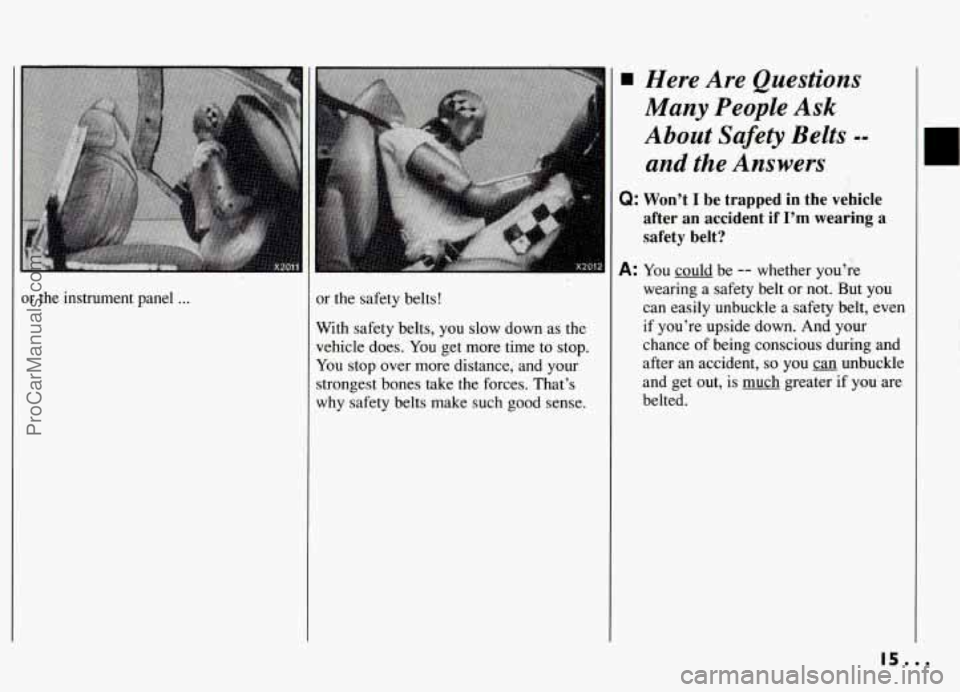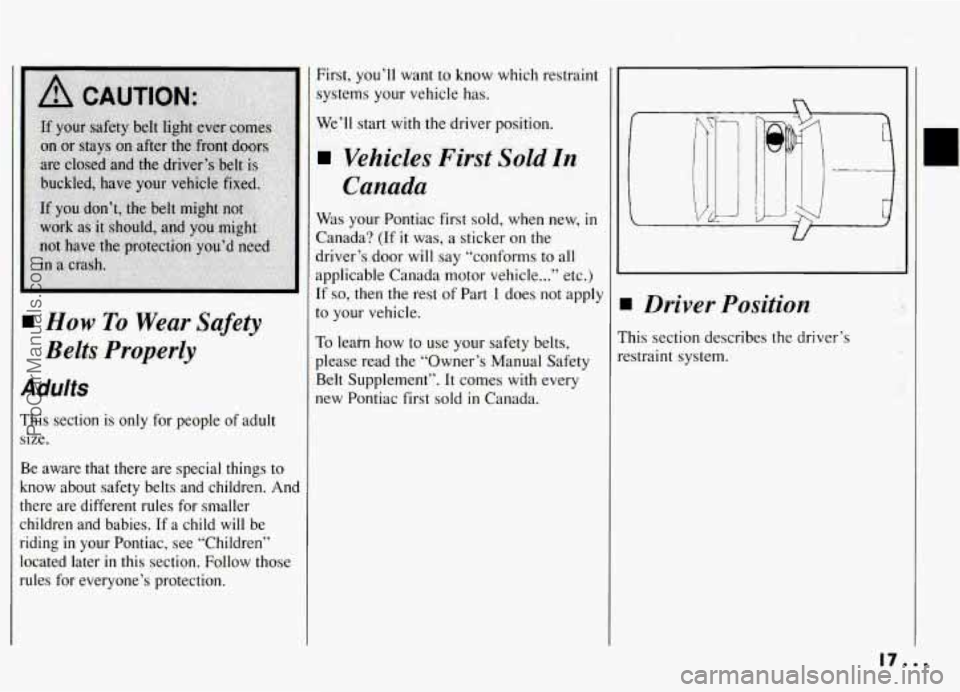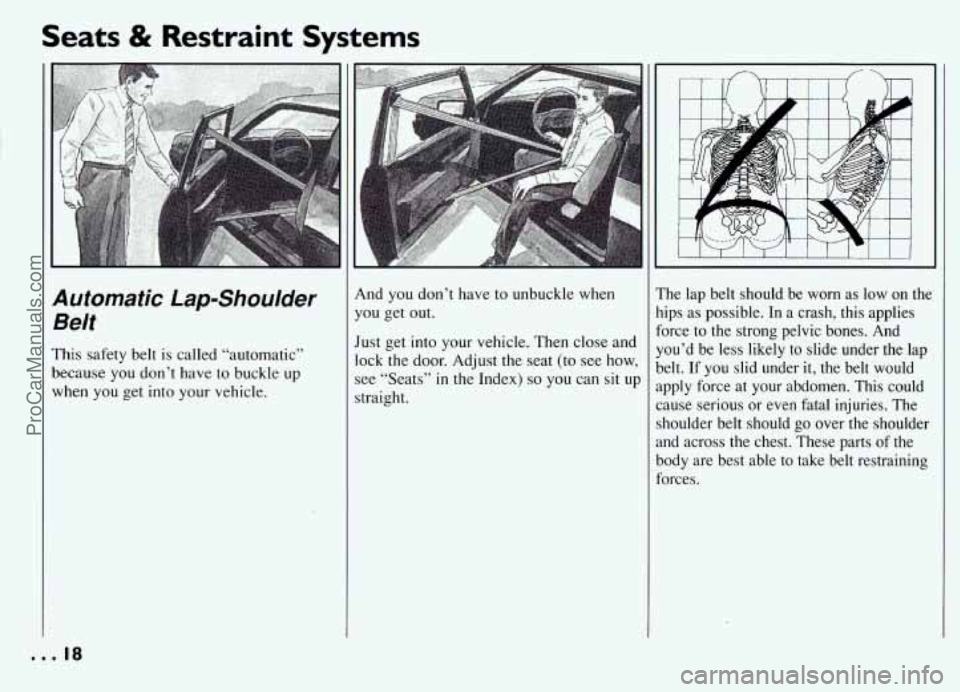1994 PONTIAC GRAND-AM belt
[x] Cancel search: beltPage 4 of 274

How to Use This Manual
It
Using Your 1994 Pontiac
Owner’s Manual
I‘
Many people read their owner’s manual
from beginning
to end when they first
receive their new vehicle. This will help
you learn about the features and controls
for your vehicle. In this manual, you’ll
find that pictures and words work
together to explain things quickly.
There are nine parts with black-tabbed
pages
in this manual. Each part begins
with a brief list of contents, so you can
usually tell at a glance
if that part
contains the information you want.
You can bend the manual slightly to reveal
the black tabs that help you find a part.
I
Part 1: Seats & Restraint Systems
This part tells you how to use your seats
and safety belts properly. It also explains
the
“SRS” (Air Bag) System.
Part 2: Features & Controls
This part,explains how to start and
operate your Pontiac.
Part 3: Comfort Controls & Audio
Systems
This part tells you how to adjust the
ventilation and comfort controls and how
to operate your sound system.
Part 4: Your Driving and the Road
Here you’ll find helpful information and
tips about
the road and how to drive
under different conditions.
Part 5: Problems on the Road
This part tells you what to do if you have
a problem while driving, such as a flat tire
or engine overheating, etc.
Part 6: Service & Appearance Care
Here the manual tells you how to keep
your Pontiac running properly and
looking good.
Part 7: Maintenance Schedule
This part tells you when to perform
vehicle maintenance and what fluids and
lubricants to use.
Part 8: Customer Assistance
Information
This part tells you how to contact Pontiac
for assistance and how to get service
publications. It
also gives you information
on “Reporting Safety Defects’’ on
page 247.
Part 9: Index
Here’s an alphabetical listing of almost
?very subject
in this manual. You can use it
to quickly find something you want to read.
Service Station Information
This is a quick reference of service
information.
You can find it on the last
page of this manual.
3.. .
ProCarManuals.com
Page 6 of 274

Vehicle Symbols
These are some of the symbols you may find on your vehicle.
For example,
these symbols
are used on an
original battery:
PROTECT
EYES BY
SHIELDING
CAUSTIC
BURNS
AVOID
SPARKS
OR
FLAMES
SPARK OR ,\I/,
COULD FLAME
EXPLODE BATTERY
These symbols
are important
for you and
your passengers
whenever your
vehicle is
driven:
DOOR LOCK
UNLOCK
FASTEN SEAT 4
BELTS
POWER
WINDOW
These symbols
have
to do with
your lights:
SIGNALS e
TURN
HIGH BEAM OR = =o
FOG LAMPS $0
These symbols
are
on some of
your controls:
WIPER Q
WINDSHIELD
WASHER
wlNDSHIELDw DEFROSTER
WINDOW REAR
DEFOGGER.
VENTILATING ca
FAN c.
These symbols
are used
on
warning and
indicator lights:
COOLANT F-
TEMP --
ENGINE
CHARGING BATTERY
SYSTEM
BRAKE (0)
RADIATOR a
COOLANT
FUEL
ENGINE OIL
PRESSURE
-4
TEMP OIL &
ANTILOCK (e)
BRAKE
Here are some
other symbols
you may
see:
FUSE *
RADIO
VOLUME
AIR
CONDITIONING
RELEASE TRUNK
LIGHTER
SPEAKER
b
ProCarManuals.com
Page 8 of 274

...
Her6 you'll find information about'the
seats in your Po.ntiac, and how ti, us0
your-safety belts properly . You can
also learn about
some thi, ngs you
should not dm o with safety belts .
I.
Seats & Restraint Sys
Seats and Seat Controls ........................................
El terns
...... 8
Part I
5. afety Belts .......... ; ............................................. 12
How to Wear Safety Belts Properly ...................................... 17
Driver Positian ...................................................... 17
Supplemental Restraint System (SRS) ....................... ............. 21
Air 'Bag Readiness Light
.............................................. 22
Servicing Your Air Bag-Equipped Pontiac
............................... 25
Safety Belt
Use During Pregnancy ..................................... 25
Right Front. Passenger Position
.........................................
Rear Seat Passengers ................................................ 26
Center Passenger Position ............................................ 27
Rear Safety Belt Comfort Guides ...................................... 30
Children
.......................................................... 32
Smaller Children and Babies
.......................................... 32
Child Restraints
.................................................... 33
LargerChildren
.................................................... 40
Safety Belt Extender
................................................ 42
Checking Your Restraint System ........................................ 42
Replacing Safety Belts After a Crash
................................... 42
. 26
I a..
ProCarManuals.com
Page 13 of 274

Seats & Restraint Systems
Safety Belts: They’re
For Everyone
This part of the manual tells you how to
use safety belts properly. It also tells you
some things you should not do with safety
belts.
And it explains the Supplemental
Restraint System, or “air bag” system.
This figure lights up as a reminder to
buckle
up. (See “Safety Belt Warning
Light”
in the Index.)
In many states and Canadian provinces,
the law says to wear safety belts. Here’s
why: They work.
You never know if you’ll be in a crash. If
you do have a crash, you don’t know
if it
will be a bad one.
A few crashes are mild, and some crashes
can be
so serious that even buckled up a
person wouldn’t survive. But most
crashes are
in between. In many of them,
people who buckle
up can survive and
sometimes walk away. Without belts they
could have been badly hurt or killed.
After more than 25 years of safety belts in
vehicles, the facts are clear. In most
crashes buckling up does matter
... a lot!
ProCarManuals.com
Page 16 of 274

or the instrument panel ... or the safety belts!
With safety belts, you slow down as the
vehicle does. You get more time to stop.
You stop over more distance, and your
strongest bones take the forces. That’s
why safety belts make such good sense.
Here Are Questions
Many People Ask
About Safety Belts
--
and the Answers
Q: Won’t I be trapped in the vehicle
after an accident if
I’m wearing a
safety belt?
A: You could be -- whether you’re
wearing a safety belt or not. But you
can easily unbuckle a safety belt, even
if you’re upside down. And your
chance of being conscious during and
after an accident,
so you can unbuckle
and get out, is much greater
if you are
belted.
ProCarManuals.com
Page 17 of 274

Seats & Restraint Systems
Here Are Questions
Many People
Ask
About Safety Belts --
and the Answers (CONT.)
Q: Why don’t they just put in air bags
so people won’t have to wear safety
belts?
A: Air bags, or Supplemental Restraint
Systems, are
in some vehicles today
and
will be in more of them in the
future. But they are supplemental
systems only
-- so they work with
safety belts, not instead of them.
Every air bag system ever offered for
sale has required the use of safety
belts. Even
if you’re in a vehicle that
has air bags, you
still have to buckle
up to get the most protection. That’s
true not only
in frontal collisions, but
especially
in side and other collisions.
Q: If I’m a good driver, and I never
drive far from home, why should I
wear safety belts?
A: You may be an excellent driver, but if
you’re in an accident -- even one that
isn’t your fault
-- you and your
passengers can be hurt. Being a good
driver doesn’t protect you from things
beyond your control, such as bad
drivers.
Most accidents occur within 25 miles
(40 km) of home. And the greatest number
of serious injuries and deaths occur at
speeds of less than
40 mph (65 km/h).
Safety belts are for everyone.
Safety Belt Warning Light
When the key is turned to “Run” or
“Start”, a chime
will come on for about
eight seconds to remind people to fasten
their safety belts, unless the driver’s safety belt is already buckled. The safety
belt
light will also come on and stay on
for 20 seconds, then it will flash for an
additional
55 seconds. If the driver’s belt
is already buckled, neither the chime nor
the light will come on.
... 16
ProCarManuals.com
Page 18 of 274

1 How To Wear Safety
Belts Properly
Idults
his section is only for people of adult
ze.
e aware that there are special things to
now about safety belts and children. And
lere are different rules for smaller
ddren
and babies. If a child will be
ding
in your Pontiac, see “Children”
tcated later
in this section. Follow those
des for everyone’s protection.
First, you’ll want to know which restraint
systems your vehicle has.
We’ll start with the driver position.
Vehicles First Sold In
Canada
Was your Pontiac first sold, when new, in
Canada? (If it was, a sticker on the
driver’s door will say “conforms to all
applicable Canada motor vehicle
...” etc.)
If so, then the rest of Part 1 does not apply
to your vehicle.
To leai-n how to use your safety belts,
please read the “Owner’s Manual Safety
Belt Supplement”. It comes with every
new Pontiac first sold
in Canada.
I
r
m
i a
I Driver Position
’his section describes the driver’s
zstraint system.
ProCarManuals.com
Page 19 of 274

Seats & Restraint Systems
automatic Lap-Shoulder
3elt
’his safety belt is called “automatic”
lecause you don’t have to buckle up
vhen you get into your vehicle.
P
Y
J1
SI
md you don’t have to unbuckle when
ou get out.
ust get into your vehicle. Then close and
Ick the door. Adjust the seat (to see how,
ee “Seats” in the Index) so you can sit up
traight.
‘
’he lap belt should be worn as low on the
ips as possible. In a crash, this applies
xce to the strong pelvic bones. And
ou’d be less likely to slide under the lap
elt. If you slid under it, the belt would
pply force at your abdomen. This could
ause serious or even fatal injuries. The
houlder belt should
go over the shoulder
nd across the chest. These parts
of the
ody are best able to take belt restraining
xces.
. . . 18
ProCarManuals.com